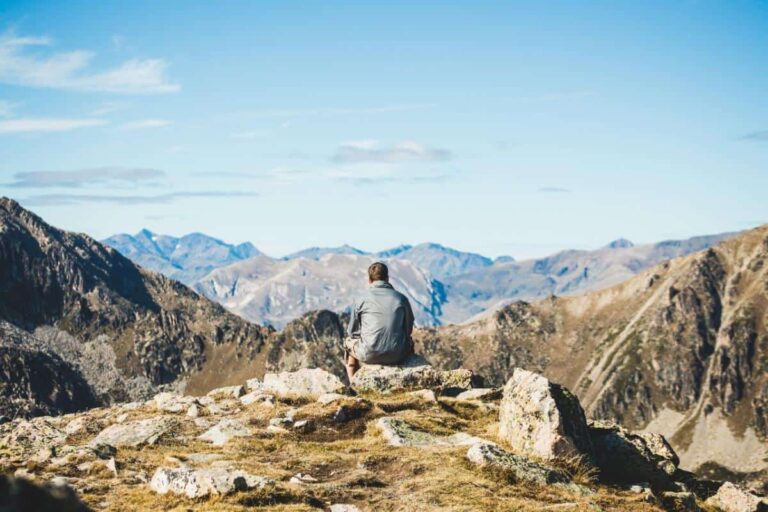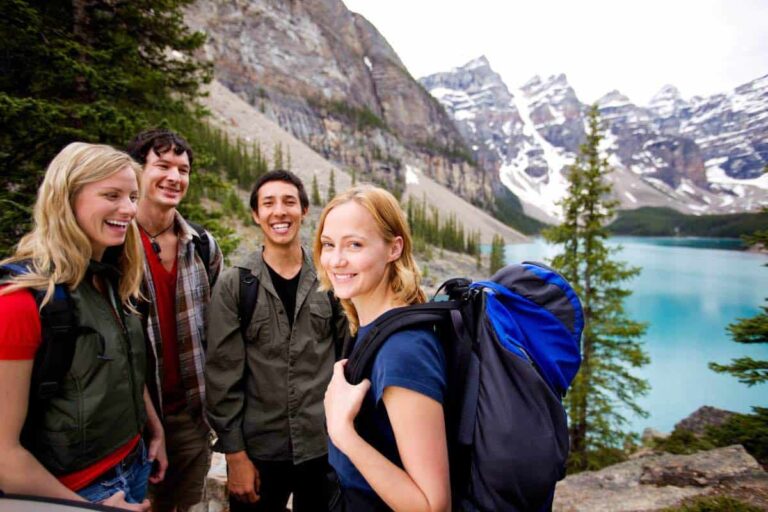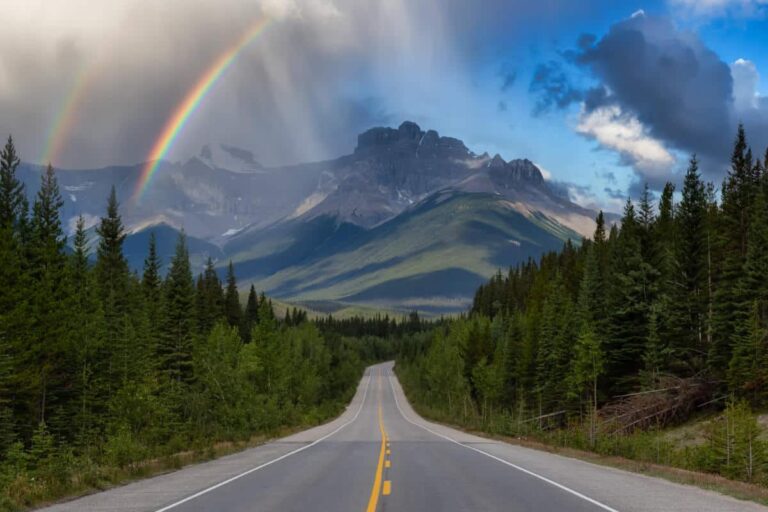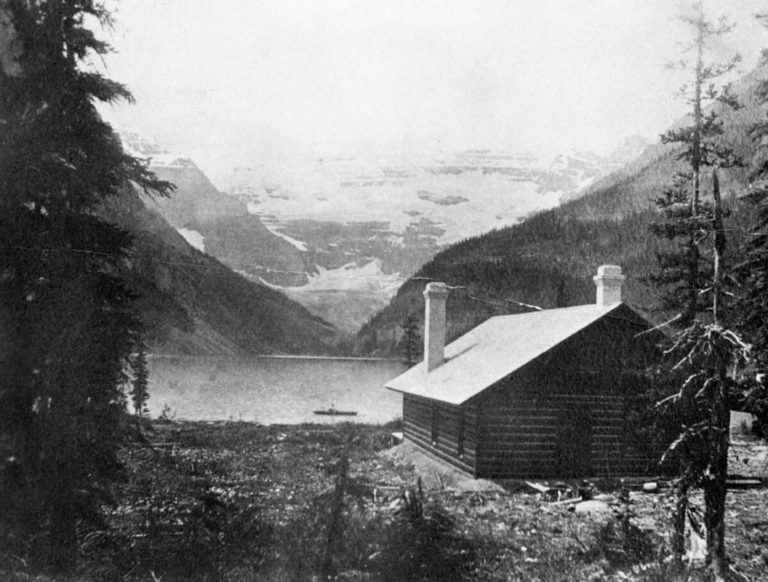See The Northern Lights In Banff (Explained!)
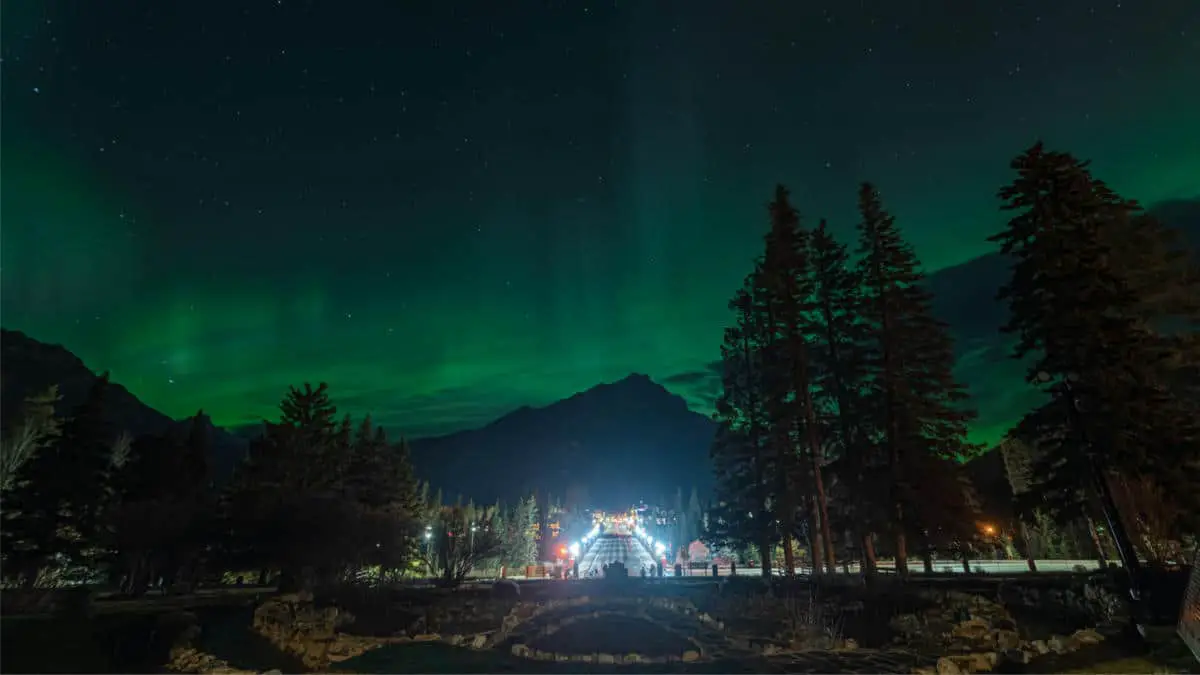
If you visit Banff in the winter, you may be lucky enough to see the northern lights over the Rockies. So you absolutely wanna know what to expect and where to find the best spots to see aurora borealis. Because missing out on this opportunity would be a shame! This guide tells you all you need to know to see the Banff Northern Lights.
The north of Alberta in Canada is known for the majestic appearance of the northern lights. Although it can be seen more often there than in Banff, it doesn’t mean you can’t also enjoy this magical natural spectacle in the Rockies. The dancing green, blue and red lights are also observed in the Rockies with some regularity, often several times a year.
If you are in Banff in the winter, it is probably worth checking whether it is possible to see the northern lights. If so, it is not difficult to imagine that it will provide stunning pictures.
When Can You See the Northern Lights in Banff?
Experts say the best time to see the northern lights is between October and March. Keep in mind that this is highly dependent on solar activity and solar wind. Ultimately, any time can be an excellent time to see the northern lights. It all depends on the sun.
For Banff National Park, you have the best chance of seeing aurora borealis from December through February. You may be lucky enough to see the northern lights in the summer, but you will have to stay up until the wee hours to do so because of the short nights.
How Well Can You See the Northern Lights?
In Banff National Park, you don’t have much trouble with so-called light pollution. Therefore, many places in the park are excellent for seeing the northern lights.
It goes without saying that it is best to avoid Banff town in particular for the best view of this natural phenomenon. The bright city lights that illuminate the sky make auroras of low intensity invisible. Although it is certainly possible to see the northern lights here as well.
Fortunately, Banff is just a town and light pollution does not reach far. Unfortunately, Banff National Park is not considered a so-called Dark Sky Preserve. In these preserves, artificial light pollution is restricted.
The purpose of these is generally to promote astronomy. Still, the Dark Sky Preserves are also ideally suited to witness the northern lights. In Alberta, five areas have been designated as Dark Sky Preserves. The closest one to Banff is Jasper National Park.
Where to Go for the Northern Lights?
In Banff, there are many great locations to see the northern lights. The list below includes sites that are easily accessible by car. This is helpful because the northern lights are difficult to predict. Sometimes it only becomes apparent a few hours in advance that aurora borealis will be visible that night.
I can imagine thinking of Lake Louise as a dream location to photograph the northern lights but aurora borealis is unfortunately not often observed there. Moraine Lake then? Bummer. You can’t get there in winter because the road to the lake is closed due to avalanche danger.
Fortunately, there are plenty of other opportunities to see this natural phenomenon in the park. Whatever you do, look around you, and not just to the north. The northern lights can appear anywhere in the sky.
Lake Minnewanka
About a ten-minute drive from Banff, you’ll find Lake Minnewanka. This is the largest lake in the park, and partly because of that, it offers expansive views and a “big” sky. Here you can count on a beautiful, dark night. In other words: little effort, great result. Highly recommended in terms of location.
Vermilion Lakes
Vermilion Lakes is literally around the corner from Banff town. You can walk there from Banff, what more could you want? Because Vermilion Lakes, like Lake Minnewanka, offers a beautiful clearing in the Rockies, it lends itself as an excellent place to see the northern lights. You can expect light pollution here because of its proximity to Banff to the east. Still, the light is likely to come from the north, so the visibility of the northern lights usually won’t be affected much here.
Castle Junction
Located halfway between Banff and Lake Louise, at the foot of Castle Mountain. This spot is easily reached via the Trans-Canada Highway (Highway 1) or Bow Valley Parkway (Highway 1A). Around the interchange, you can easily find a place to safely park and set yourself up.
Peyto Lake
Located on the Icefields Parkway (Highway 93 N), Peyto Lake is easy to reach. From the Peyto Lake Lookout you have a fantastic view of the lake but, more importantly, a view of an endless sky. The only disadvantage is that you have to walk uphill to get to the lookout. Doing this in the dark is probably not so pleasant. Make sure you bring a good flashlight and spare batteries. The light from your phone camera is perhaps not enough.
Icefields Parkway
The Icefields Parkway (Highway 93 N) in itself makes an excellent location for seeing the northern lights. This road between Lake Louise and Jasper is considered one of the most beautiful roads on earth. A spectacular backdrop is guaranteed if you are lucky enough to see the northern lights here.

How Are the Northern Lights Created?
Everyone knows the northern lights, has seen them in photos or videos, those stunning colors in the night sky. But what exactly is this spectacular natural phenomenon?
The northern lights appear as red or green light streams in the sky, especially near the northern or southern magnetic poles. This natural electrical phenomenon is caused by the interaction of charged particles from the sun with atoms in the upper atmosphere. The energy released in the process results in light of varying color and intensity.
These charged particles are hurled into the universe by the sun. This stream of particles is called solar wind. These solar wind particles travel at speeds between 300 and 1000 kilometers (185 and 617 miles) per second, covering the distance between the sun and the earth in two to three days. This makes it possible to predict significant auroral phenomena several days in advance.
Solar activity is variable and cyclic, which means it constantly changes but follows cycles. These cycles last for eleven years. Unfortunately, it is impossible to predict solar activity. Therefore, you have to be a bit lucky to be in the right place at the right time to see aurora borealis.
Colors of the Northern Lights
The northern lights present themselves in several colors. Green, blue, red, and violet are the most common, but white-gray light is observed as well. Green occurs from 100 to 240 kilometers (62 to 148 miles) above the earth’s surface. Blue and violet appear below 100 kilometers (62 miles) and red above 240 kilometers (148 miles). The color you see the most is green.
How to Prepare for the Northern Lights?
If you want to see the northern lights in Banff, you should check the forecasts. You can find them on University of Alberta’s Aurora Watch, or check Auroraforecast.com for the level of geomagnetic activity, responsible for the northern lights. You can also visit Spaceweather Canada. The site has a separate page on geomagnetic activity.
In addition, it is wise to consult the so-called KP index. This index indicates disturbances in the “horizontal component of the Earth’s magnetic field” on a scale of 0-9. The number 1 indicates calm or quiet, 5 or more indicates a geomagnetic storm. In the latter case, the chances of seeing the northern lights are real.
If the forecasts are in your favor, head out, and make sure you put on warm clothes (the chances of seeing the northern lights are most significant in winter). Take a good photo camera with you, and allow for a short(er) night’s sleep.
What Are the Chances of Seeing the Northern Lights?
The chances are, unfortunately, not very high. There are many factors on which you depend. And it’s not just about the value of the KP index. You also need a clear night without clouds.
Moon light can also act as a disturbance. Especially if it is a full moon. So, again, check the local weather forecast before you head out.
Overall, to maximize your chances of seeing the northern lights in Banff National Park, you’ll want to choose a clear night with minimal light pollution. Keep an eye on the weather forecast and lunar calendar, and be patient – the northern lights’ appearance can be unpredictable.
Can You See the Northern Lights from Banff Town or Lake Louise?
In theory, you can see the northern lights from Banff or Lake Louise. But due to the relatively high level of light pollution the location is not ideal. Of course, should it be visible, you’ll walk outside quickly enough.
Do You Need Eye Protection?

No, fortunately not. The luminosity of the aurora borealis is so low that you can see it with the naked eye without any problems. In fact, sometimes the northern lights are not visible to the naked eye when they are actually present. Still, it is advisable to bring sunglasses, even when dark. Ultraviolet reflects four times harder than usual on snow.
What Tours Are Available to See the Northern Lights?
A tour for Banff National Park itself is not available unfortunately. Because the northern lights are best and most often seen in the north of Canada, several northern lights tours can be booked for this part of Canada.
You must think of a trip from Yellowknife in Northwest Territories. This is no less than 1865 km (1151 mi) from Banff. From Vancouver, you can also book an aurora tour. Still, you’ll travel to faraway Whitehorse in Yukon Territory on this four-day trip.
What’s the Best Way to Photograph the Northern Lights?
Now that you’re heading out to see the northern lights, you’d better capture them, too, especially with those fantastic colors. So take your camera along, and you might just take the most beautiful pictures you’ve ever taken.
You Will Need the Following Equipment:
- A camera that allows long exposures (at least 10 seconds)
- A sturdy tripod against vibrations
- A cable release or remote control, also to prevent vibrations
- A wide-angle lens (not necessary, but recommended)
Technique
To photograph the northern lights, f/2.8 is recommended or the largest available aperture in your lens, ISO 3200-6400, and a shutter speed of 1 to 15 seconds. The ideal shutter speed depends on the activity of the northern lights. Adjust your white balance to 3500K. The faster the aurora moves, the quicker you should set your shutter speed.
How Do I Do this with My Cell Phone’s Camera?
You can capture the northern lights on your smartphone using landscape mode. Turn off your flash and set the focus to manual. Then put your camera to night mode and use the highest resolution possible. For better results, use a tripod and a BlueTooth remote control.
Quick Tips for Watching the Northern Lights in Banff
- Plan your visit during the fall or winter months, as this is when the northern lights are most visible.
- Check the forecast for aurora activity before you go out to view the lights. You can find this information on websites like SpaceWeatherLive or AuroraWatch.
- Find a spot with a clear view of the northern horizon, away from any light pollution. Banff National Park has plenty of great spots for viewing the northern lights, such as Lake Minnewanka or the Vermilion Lakes (see above).
- Dress warmly and bring plenty of layers, as temperatures can drop well below freezing at night.
- Bring a camera with a tripod to capture the beauty of the lights. A wide-angle lens and a remote shutter release can also be helpful.
- Be patient and give yourself plenty of time to enjoy the experience. The northern lights can be unpredictable, so you may need to wait a while for them to appear.
Northern Lights FAQ
1. Are the Northern Lights and the Southern Lights the same?
The northern lights and the southern lights are not the same. The northern lights, or aurora borealis, occur in the northern hemisphere, while the southern lights, or aurora australis, occur in the southern hemisphere.
While they are both caused by the interaction between charged particles from the sun and the Earth’s magnetic field, they can appear differently due to differences in the magnetic field and atmosphere of each hemisphere.
2. How does moonlight affect the Northern Lights?
Moonlight can affect the visibility of the northern lights. A bright moon can create light pollution, making it more difficult to see the lights. Therefore, it’s best to view the northern lights during a new moon or a moonless night.
3. Can you see the Northern Lights from space?
Yes, the northern lights can be seen from space. Astronauts on the International Space Station have reported seeing the lights from above, and satellites have captured images of the aurora from space.
4. Are the Northern Lights harmful to humans?
The northern lights are not harmful to humans. They are a natural phenomenon caused by the interaction between the sun and the Earth’s magnetic field, and pose no danger to human health.
5. Do sunspots affect the Northern Lights?
Yes, sunspots can affect the northern lights. Sunspots are areas of intense magnetic activity on the sun’s surface, and when they release energy in the form of solar flares or coronal mass ejections, they can cause geomagnetic storms on Earth that can trigger the northern lights.
6. Is wildlife affected by the Northern Lights?
It’s unclear whether wildlife is affected by the northern lights. While there have been reports of animals reacting to the lights, such as reindeer herding towards the aurora, there is no scientific evidence to suggest that the northern lights have a significant impact on wildlife behavior or health.
7. Do the Northern Lights make a sound?
The northern lights do not make a sound. While there have been reports of people hearing crackling or hissing sounds during auroral displays, these sounds are not actually caused by the northern lights themselves, but rather by other natural phenomena such as electrical discharges in the atmosphere.
Banff Travel Guide and FAQ
Where is Banff National Park, Canada?
Banff National Park is in the southwest of the province of Alberta. It’s home to the towns of Banff and Lake Louise and borders the province of British Columbia in the west of Canada. You can easily access famous places like Lake Louise, Moraine Lake, Peyto Lake and the stunning Icefields Parkway from these locations.
Banff and Lake Louise are situated in the Rocky Mountains of Alberta, close to the boundary with British Columbia, as shown on the map of Banff National Park below.
Is Banff, Canada safe?
Generally speaking, yes. Like most areas, Banff has crime, but it’s still a safe travel place. But Banff has a lot of wildlife, including bears and cougars, so you should always carry bear spray and exercise caution when hiking in the mountains.
What is the best time to Travel to Banff, Canada?
The best time to travel to Banff, Canada, depends on your reason for visiting the park. If you’re going for the stunning nature the park’s famous for, you’d better visit from June to September. The best months to ski are from January through March.
WEATHER IN BANFF, CANADA: AVERAGE TEMPERATURE

The worst months to visit Banff National Park are November, April and May. It’s too chilly to go sightseeing in November, and there isn’t enough snow on the slopes yet. The iconic lakes in the park are still frozen in April and May, and it can still be quite cold.
How do I travel to Banff, Canada?
Want to fly to Banff? Calgary International Airport (Code: YYC) is the closest airport. It’s 130 kilometers (81 mi) to the east of Banff.
Several cities, including Toronto, Chicago, Seattle, and Dallas/Fort Worth, have direct flights into Calgary.
Pick up a rental vehicle at Calgary International Airport, or take a private transport service to your destination. The trip to the park takes about 1 hour and 40 minutes.
Viator has several good options. Click the link to check the options and latest rates.
Banff Car Rental
Want to rent a car during your stay in Banff National Park? Rent one at Calgary International Airport or in the city of Calgary. Yep, there are rental firms in Lake Louise and Banff, but as these are small towns, your rental options can be limited.
Avis is a reputable car rental company, which I’ve used many times. Book now with Avis
What do I pack for Banff, Canada?
The time of year will affect what you should bring with you on your trip to Banff, Canada. If you plan to spend your summer vacation in Banff National Park, you should be okay with light-colored, breathable clothing. Bring a few sweaters, too, as Banff’s summer evenings can be chilly. You’re in the mountains, after all.
When visiting in winter, bring a heavy jacket, such as a parka, and other winter clothing, such as warm pants, long underwear, and (fleece) sweaters. Don’t take it lightly because Banff’s wintertime lows can reach well below zero.
Banff Travel Planning Guide
Do I need a visa for Banff?
Most likely not. Citizens of the US, most European countries, Australia and New Zealand don’t need a visa to enter Canada. Not sure? Click the link to see whether you need a visa or not. The typical length of stay in Canada for people with visa-exempt passports is 90 days.
Do I need travel insurance for Banff?
You bet. Feel confident while traveling with a plan from Travel Insurance Master, one of the top names in travel insurance, for just USD 10 on average per day.
What’s the best way to book my Banff accommodation?
If you plan to book a hotel, hostel or bed & breakfast, Booking.com is your best bet. It has the most hotels listed and often offers the best rates.
Do I need to rent a car in Banf?
Absolutely. While Banff is one of the few national parks in North America with a sizeable public transport network, I strongly advise renting a car if you want to make the most of your visit.
Will my phone work in Banff?
It depends. In the towns of Banff and Lake Louise, you should have good to excellent reception. However, in more remote areas, the signal is spotty. In many places, there will be no signal at all.
What’s the best site to buy Banff flights?
If you’re looking for cheap flights to Banff, I recommend Skyscanner. No surprises with suddenly increased rates (for taxes, seats or luggage) upon checkout. What you see is what you get.

